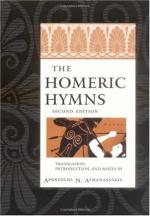“The Peruvians, we are told, believed all useful plants to be animated by a divine being who causes their growth,” says Mr. Frazer. {67} The genealogical table, then, in my opinion, is:—
Divine Being of the Grain. | +---------+--------------------------+ | | (Anthropomorphized). (Zoomorphised). Mother of Corn. Pig, Horse, Demeter. and so on.
Thus the Greek genius had other and better materials to work on, in evolving Demeter, than the rather lowly animal which is associated with her rites. If any one objects that animal gods always precede anthropomorphic gods in evolution, we reply that, in the most archaic of known races, the deities are represented in human guise at the Mysteries, though there are animal Totems, and though, in myth, the deity may, and often does, assume shapes of bird or beast. {68}
Among rites of the backward races, none, perhaps, so closely resembles the Eleusinian Mysteries as the tradition of the Pawnees. In Attica, Hades, Lord of the Dead, ravishes away Persephone, the vernal daughter of Demeter. Demeter then wanders among men, and is hospitably received by Celeus, King of Eleusis. Baffled in her endeavour to make his son immortal, she demands a temple, where she sits in wrath, blighting the grain. She is reconciled by the restoration of her daughter, at the command of Zeus. But for a third of the year Persephone, having tasted a pomegranate seed in Hades, has to reign as Queen of the Dead, beneath the earth. Scenes from this tale were, no doubt, enacted at the Mysteries, with interludes of buffoonery, such as relieved most ancient and all savage Mysteries. The allegory of the year’s death and renewal probably afforded a text for some discourse, or spectacle, concerned with the future life.




